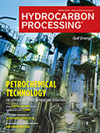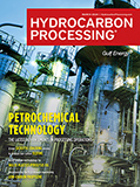Equipment
Editorial Comment: As petrochemicals demand increases globally, novel processes, systems and technologies continue to evolve
Over the next 25 yr, global petrochemicals demand is forecast to increase exponentially, rising from approximately 450 MMtpy in 2025 to > 500 MMtpy in 2035 and upwards to nearly 600 MMtpy by 2050.
Control primary properties online in polyethylene and polypropylene rectors by using functional correlations
Polyolefins products such as high-density polyethylene (HDPE), linear low-density polyethylene (LLDPE), low-density polyethylene (LDPE) and polypropylene (PP) form approximately 65%–70% of all polymers manufactured globally.
Safety study demonstrates the need for new safety rules for methanol-fueled vessels
A new fire safety study by global Survival Technology solutions provider Survitec has revealed that existing firefighting methods used to extinguish machinery space spray and pool fires on conventionally fueled vessels are inadequate when dealing with methanol-based fires.
thyssenkrupp nucera to supply electrolyzers for ABEL Energy’s Bell green methanol project
ABEL Energy announced thyssenkrupp nucera as the preferred supplier of the 260MW of electrolyzers required for their flagship green methanol project in Bell Bay, Tasmania, Australia.
Yokogawa launches OpreX Robot Management Core
Yokogawa Electric Corporation announced the development and release of OpreX Robot Management Core, a software application in the OpreX Asset Management and Integrity family and will go on sale on March 22, 2024.
ITT invests $11 MM to enhance pump testing in Germany, India, and Saudi Arabia, aiding growth and large project ventures
ITT Inc. announced an approximately $11-MM investment to expand testing capabilities at three of its industrial process sites to enhance capacity for large project awards in its flow business, reinforcing the company’s commitment to an exceptional customer experience.
Rem Offshore orders next generation vessel powered by dual-fuel methanol engines
Rem Offshore and Myklebust Verft have signed a contract for the construction of an Energy Subsea Construction Vessel with a 250 ton crane and will be equipped with dual-fuel methanol engines in combination with battery packs.
First carbon capture pilot rig delivered by Compact Membrane Systems
Compact Membrane Systems announced that it has delivered a carbon capture pilot rig to OMV, a leading petrochemical company in Austria.
Ukrainian drones attack Russian oil refinery in Kaluga region
Ukraine attacked a small oil refinery in Russia's Kaluga region with drones, causing damage in an operation that was conducted by the GUR military spy agency.
Report: 80% of Petrochemical Process Engineers Concerned Power Equipment Could Affect Refinery Operations
New reports exploring the European petrochemicals industry has discovered over 80% of its process engineering professionals are concerned their current power equipment could affect refinery operations.

- KBR's phenol technology selected by SABIC Fujian Petrochemicals 4/25
- Honeywell Technology helping to produce SAF with lower cost and waste 4/25
- Nigeria's NNPC partners local firm on new 100,000 bpd refinery 4/25
- Stranded cargo shows credit challenges at Nigeria's Dangote refinery 4/25
- Low U.S. distillate consumption reflects slow economic activity and biofuel substitution 4/25
- Clariant catalysts reduce customers’ footprints by 40 million tons of CO2e in 2023 4/25




